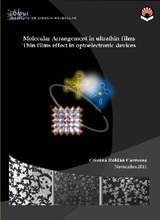Mostrar el registro sencillo del ítem
Molecular Arrangement in ultrathin films. Thin films effect in optoelectronic devices
| dc.contributor.advisor | Camacho Delgado, Luis | |
| dc.contributor.advisor | Bolink, H. | |
| dc.contributor.author | Roldán-Carmona, C. | |
| dc.date.accessioned | 2014-11-18T10:08:56Z | |
| dc.date.available | 2014-11-18T10:08:56Z | |
| dc.date.issued | 2014 | |
| dc.identifier.uri | http://hdl.handle.net/10396/12444 | |
| dc.description.abstract | The evolution of technology has to meet the energetically needs of actual societies and be respectful for the environment through a sustainable and efficient use of energy. In this context organic electronic represents a promising technology. Organic semiconductors are abundant, easy to fabricate and their properties can be easily tuned. In the form of thin films, they exhibit interesting electronic and magnetic properties, which in many cases result from the specific molecular organization and interactions of their components. A low cost organic alternative to the classical lighting systems are the light-emitting electrochemical cells (LECs),. They require only one ionic emitting layer, are processed at ambient conditions and are compatible with air stable electrodes, avoiding rigorous encapsulation in inert atmosphere. Recently, LECs have shown high luminance, high efficiencies and relatively high stabilities when specific emitters were used. However, their slow response, their selflimiting nature and the absence of efficient white light emission, remain the limitations preventing their application in general lighting. On the other hand, organic thin films can also be used in photovoltaics, which represents an abundant and low cost alternative to the silicon established solar cell technology. Nevertheless, their record efficiency (~ 12%) is still below the requirements for a massive application. This suggests the need of new materials and configurations to achieve efficiencies close to those obtained in inorganic Si-cells (20 - 25%) but reducing the manufacturing costs. In this Thesis, thin films are studied from two different points of view: as organized ultra-thin systems containing UV-Vis absorbing molecules, frequently used in many optoelectronic devices; and as interlayers in LECs and OPV devices. In the first case, two superficial techniques, the Brewster Angle Microscopy and the UV-Vis Reflection Spectroscopy, are studied in order to obtain useful information from such highly organized systems. A new detailed description of the theoretical treatment needed for each technique is presented, which provides, through a relatively simple... | es_ES |
| dc.format.mimetype | application/pdf | es_ES |
| dc.language.iso | eng | es_ES |
| dc.publisher | Universidad de Córdoba, Servicio de Publicaciones | es_ES |
| dc.rights | https://creativecommons.org/licenses/by-nc-nd/4.0/ | es_ES |
| dc.subject | Ultrathin films | es_ES |
| dc.subject | Organic electronic | es_ES |
| dc.subject | Optoelectric devices | es_ES |
| dc.subject | Películas ultrafinas | es_ES |
| dc.subject | Dsipositivos electroliminiscentes y fotovoltaicos | es_ES |
| dc.subject | Electrónica orgánica | es_ES |
| dc.title | Molecular Arrangement in ultrathin films. Thin films effect in optoelectronic devices | es_ES |
| dc.title.alternative | Formación de nuevas estructura moleculares en películas ultrafinas.Preparación de dispositivos electroluminiscentes y fotovoltaicos | es_ES |
| dc.type | info:eu-repo/semantics/doctoralThesis | es_ES |
| dc.rights.accessRights | info:eu-repo/semantics/openAccess | es_ES |

